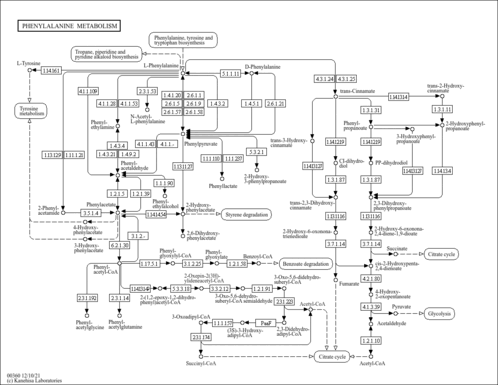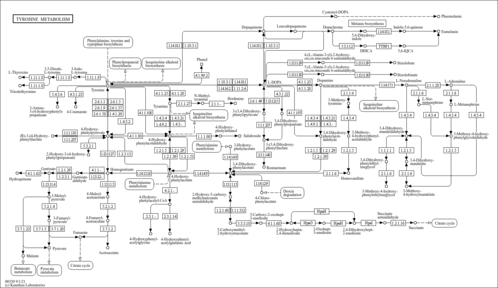| Record Information |
|---|
| Version | 1.0 |
|---|
| Created at | 2020-04-17 18:52:17 UTC |
|---|
| Updated at | 2020-11-18 16:39:03 UTC |
|---|
| CannabisDB ID | CDB004936 |
|---|
| Secondary Accession Numbers | Not Available |
|---|
| Cannabis Compound Identification |
|---|
| Common Name | 4a-Hydroxytetrahydrobiopterin |
|---|
| Description | 4a-Hydroxytetrahydrobiopterin, also known as 4a-HTHB, belongs to the class of organic compounds known as biopterins and derivatives. These are coenzymes containing a 2-amino-pteridine-4-one derivative. They are mainly synthesized in several parts of the body, including the pineal gland. 4a-Hydroxytetrahydrobiopterin is a strong basic compound (based on its pKa). 4a-Hydroxytetrahydrobiopterin exists in all living organisms, ranging from bacteria to humans. dopamine and 4a-hydroxytetrahydrobiopterin can be biosynthesized from L-dopa and tetrahydrobiopterin; which is mediated by the enzyme aromatic-L-amino-acid decarboxylase. In humans, 4a-hydroxytetrahydrobiopterin is involved in the metabolic disorder called tyrosinemia, transient, of the newborn. A 4a-hydroxytetrahydrobiopterin which has R configuration at position 6 and in which the dihydroxypropyl substituent has L-erythro configuration. 4a-Hydroxytetrahydrobiopterin is expected to be in Cannabis as all living plants are known to produce and metabolize it. |
|---|
| Structure | |
|---|
| Synonyms | | Value | Source |
|---|
| (4AS,6R)-4a-hydroxy-L-erythro-5,6,7,8-tetrahydrobiopterin | ChEBI | | (6R)-6-(L-Erythro-1,2-dihydroxypropyl)-5,6,7,8-tetrahydro-4a-hydroxypterin | ChEBI | | 4a-Hydroxy-5,6,4,8-tetrahydrobiopterin | Kegg | | 6-[(1R,2S)-1,2-Dihydroxypropyl]-5,6,7,8-tetrahydro-4a-hydroxypterin | Kegg | | 4a-HTHB | HMDB | | 4a-Hydroxy-5,6,7,8-tetrahydrobiopterin | HMDB | | 4a-Hydroxy-L-erythro-5,6,7,8-tetrahydrobiopterin | HMDB | | 4a-Hydroxytetrahydrobiopterin | HMDB |
|
|---|
| Chemical Formula | C9H15N5O4 |
|---|
| Average Molecular Weight | 257.25 |
|---|
| Monoisotopic Molecular Weight | 257.1124 |
|---|
| IUPAC Name | (4aS,6R)-2-amino-6-[(1R,2S)-1,2-dihydroxypropyl]-4a-hydroxy-4,4a,5,6,7,8-hexahydropteridin-4-one |
|---|
| Traditional Name | (4aS,6R)-2-amino-6-[(1R,2S)-1,2-dihydroxypropyl]-4a-hydroxy-5,6,7,8-tetrahydropteridin-4-one |
|---|
| CAS Registry Number | 1379003-93-6 |
|---|
| SMILES | [H][C@@]1(CNC2=NC(N)=NC(=O)[C@]2(O)N1)[C@@H](O)[C@H](C)O |
|---|
| InChI Identifier | InChI=1S/C9H15N5O4/c1-3(15)5(16)4-2-11-6-9(18,14-4)7(17)13-8(10)12-6/h3-5,14-16,18H,2H2,1H3,(H3,10,11,12,13,17)/t3-,4+,5-,9-/m0/s1 |
|---|
| InChI Key | KJKIEFUPAPPGBC-XXKOCQOQSA-N |
|---|
| Chemical Taxonomy |
|---|
| Description | Belongs to the class of organic compounds known as biopterins and derivatives. These are coenzymes containing a 2-amino-pteridine-4-one derivative. They are mainly synthesized in several parts of the body, including the pineal gland. |
|---|
| Kingdom | Organic compounds |
|---|
| Super Class | Organoheterocyclic compounds |
|---|
| Class | Pteridines and derivatives |
|---|
| Sub Class | Pterins and derivatives |
|---|
| Direct Parent | Biopterins and derivatives |
|---|
| Alternative Parents | |
|---|
| Substituents | - Biopterin
- Alpha-amino acid or derivatives
- Pyrimidone
- Imidolactam
- Hydropyrimidine
- 1,4,5,6-tetrahydropyrimidine
- Pyrimidine
- 1,2-diol
- Amino acid or derivatives
- Guanidine
- N-acylimine
- Secondary alcohol
- Alkanolamine
- Amidine
- Carboxylic acid amidine
- Carboxylic acid derivative
- Azacycle
- Organic 1,3-dipolar compound
- Propargyl-type 1,3-dipolar organic compound
- Carboximidamide
- Secondary amine
- Carbonyl group
- Organic nitrogen compound
- Organic oxygen compound
- Alcohol
- Amine
- Organonitrogen compound
- Organooxygen compound
- Organic oxide
- Hydrocarbon derivative
- Aliphatic heteropolycyclic compound
|
|---|
| Molecular Framework | Aliphatic heteropolycyclic compounds |
|---|
| External Descriptors | Not Available |
|---|
| Ontology |
|---|
|
| Disposition | Biological location: Source: |
|---|
| Physical Properties |
|---|
| State | Solid |
|---|
| Experimental Properties | | Property | Value | Reference |
|---|
| Melting Point | Not Available | Not Available | | Boiling Point | Not Available | Not Available | | Water Solubility | Not Available | Not Available | | logP | Not Available | Not Available |
|
|---|
| Predicted Properties | [] |
|---|
| MS/MS | | Type | Description | Splash Key | View |
|---|
| Predicted MS/MS | Predicted LC-MS/MS Spectrum - 10V, Positive | splash10-0a4l-0090000000-364ec2c50acd77d83ef0 | 2019-02-23 | View Spectrum | | Predicted MS/MS | Predicted LC-MS/MS Spectrum - 20V, Positive | splash10-00gl-0690000000-f15f00b5ba6b8f2959b9 | 2019-02-23 | View Spectrum | | Predicted MS/MS | Predicted LC-MS/MS Spectrum - 40V, Positive | splash10-0005-9720000000-9884aa4c6eb7899b87e9 | 2019-02-23 | View Spectrum | | Predicted MS/MS | Predicted LC-MS/MS Spectrum - 10V, Negative | splash10-0bt9-2290000000-43723819afb4c98b5ceb | 2019-02-23 | View Spectrum | | Predicted MS/MS | Predicted LC-MS/MS Spectrum - 20V, Negative | splash10-0006-9210000000-fa8eb33fdfed731f1c82 | 2019-02-23 | View Spectrum | | Predicted MS/MS | Predicted LC-MS/MS Spectrum - 40V, Negative | splash10-0006-9100000000-c550affb7745a16d59b4 | 2019-02-23 | View Spectrum | | Predicted MS/MS | Predicted LC-MS/MS Spectrum - 10V, Positive | splash10-0a4i-0090000000-2e38d752208e421512bf | 2021-09-23 | View Spectrum | | Predicted MS/MS | Predicted LC-MS/MS Spectrum - 20V, Positive | splash10-052f-0390000000-b6be9ce0bc335a474657 | 2021-09-23 | View Spectrum | | Predicted MS/MS | Predicted LC-MS/MS Spectrum - 40V, Positive | splash10-014i-1900000000-d33dcfe8d8e5a4b0dbc4 | 2021-09-23 | View Spectrum | | Predicted MS/MS | Predicted LC-MS/MS Spectrum - 10V, Negative | splash10-0a4i-0190000000-41b062345c98026b7320 | 2021-09-25 | View Spectrum | | Predicted MS/MS | Predicted LC-MS/MS Spectrum - 20V, Negative | splash10-0bti-1390000000-91a5c824226e2ce65d2b | 2021-09-25 | View Spectrum | | Predicted MS/MS | Predicted LC-MS/MS Spectrum - 40V, Negative | splash10-001l-4900000000-3857d5c10638c2febd7c | 2021-09-25 | View Spectrum |
|
|---|

